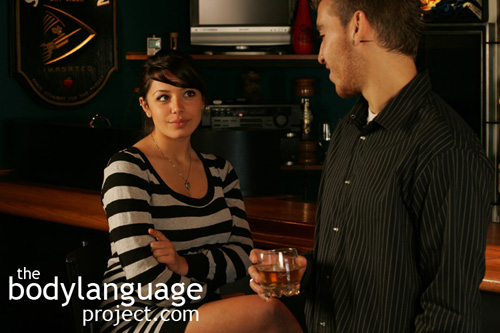The chapter has a heavy focus on ways that women attract sexual attention, but there were a few hints dropper here and there with regards to ways women can avoid attention. The problem as women might view it is that most of the tactics involved dropping cues, or ‘inaction’ rather than actionable body language. Because there are times when women require the opposite result, I have devoted this section to ways women can actively send rejection signals. It is far easier and less embarrassing to use nonverbal language to send negative signals and they can be implemented earlier to reduce escalation before it’s too late. Women far too often make the mistake of placating others to their own detriment. When men are bored, they feel no pain, no discomfort, no desire to offer anything other than a barren despondent look on their face. It might surprise you to hear me say to this, congratulations! Men who show their true emotions have mastered, all-be-it passively, the use of effective body language and use it to convey their boredom to others. When men are bored, they say “shape up or ship out”, women should heed this and follow. So women, please pay careful attention to the tips that follow to avoid unwanted approaches.
My conclusions are drawn in large part from the research of Dr. Monica Moore in 1998 who looked at rejection patterns in women. She found seventeen main behaviours in her study that indicated rejection of potential male partners. They included facial expressions such as yawning, frowning, sneering, gaze avoidance, upward gaze, hair gaze (looking at one’s own hair), looking away, and staring, as well as gestures such as negative head shaking, nail cleaning, teeth picking or pocketing hands, and finally, posture patterns such as arm crossing, holding the trunk rigidly, closed legs, body contact avoidance or pulling away. Here they are by category in a bit more detail.
_____________________________________________________________________________________________
Gaze avoidance happens when the woman refused to make eye contact with the man, despite him looking directly at her. She will look at other people, make eye contact with someone else, or pretend to be taken by something else in the room. This can and in fact, should be done while a man is currently speaking. Buck up women, grow some and spell it out! Look at it this way, you’re saving him time by being direct and upfront and in the long run, he might even thank you if it gives him the time to pursue someone else. To display disinterest a women can also look upward by raising the chin only a quarter inch or look at the ends of her hair which is a strong signal of boredom and detachment. Any behaviours should include prolonged inattention, lasting at least ten seconds, but more is always better! Staring is also used, in this case staring lasts multiple seconds or until the man looks away, but when he does, don’t look him over, start a conversation with someone else or leave altogether without saying anything. If none of these messages seem to be working, add frowns or sneers to your repertoire. The sneer happens with furrowed brows and the mouth is compressed and turned downward. The sneer happens when the mouth is twisted and the nose wrinkled. Next you can use head shaking and yawning which shows negative thoughts rather than using more affirmative head movements such as nods.
_____________________________________________________________________________________________
Gestures are nonverbal rejection patterns that involved movement of the hands and arms. Interested women perform palm displays, however, disinterested women will pocket their hands instead, or cross their arms over their chest. To further disinterest, an increase in distance would occur by taking steps backwards or using barriers to reduce closeness. Self grooming can also be used to show disinterest, but not in a flirtatious way. Instead picking the nails, or teeth is used to turn men off and efficiently display disinterest.
_____________________________________________________________________________________________
Posture patterns involve movement and positioning of the body. These are tied to closed body positions and include such items as tightly crossing the legs, legs crossed at the ankles or hidden under a chair. Other postures include a rigid upright torso and positions that avoided body contact and if contact was initiated the women would pull away. Leaning back and turning the back to the man is also effective.
_____________________________________________________________________________________________
Whatever cues you plan on using, be sure of your intent before emitting them. If you are serious about rejecting someone it is important that you be deliberate, predictable and consistent. If you flip-flop from positive to negative cues, he’ll just think that you are “moody” which will create a situation that makes negative cues less effective in the future. It will also prolong pursuit because the positive cues mixed into the interaction will provide him incentives to continue. Finally, be prepared to be called bad names like “grumpy” and of course “bitch.” It is unfortunate for women that they aren’t given the same latitude as men in terms of their ability to display negative emotions in an outward fashion, but this is the world we live in and no amount of complaining will change it. The research tells us that women are expected to smile even if unhappy, and be chipper when depressed, but when it comes to rejecting someone, it’s best done quickly and without remorse. Afterall, when it comes to rejection, do you really care what their opinion is of you?
If this sort of tactic makes you uncomfortable, you are welcome to use an integrity based, verbal rejection. “Sorry, I’m not interested” will work just fine in most cases. Whatever method you choose, it will be you that has to live by it.








